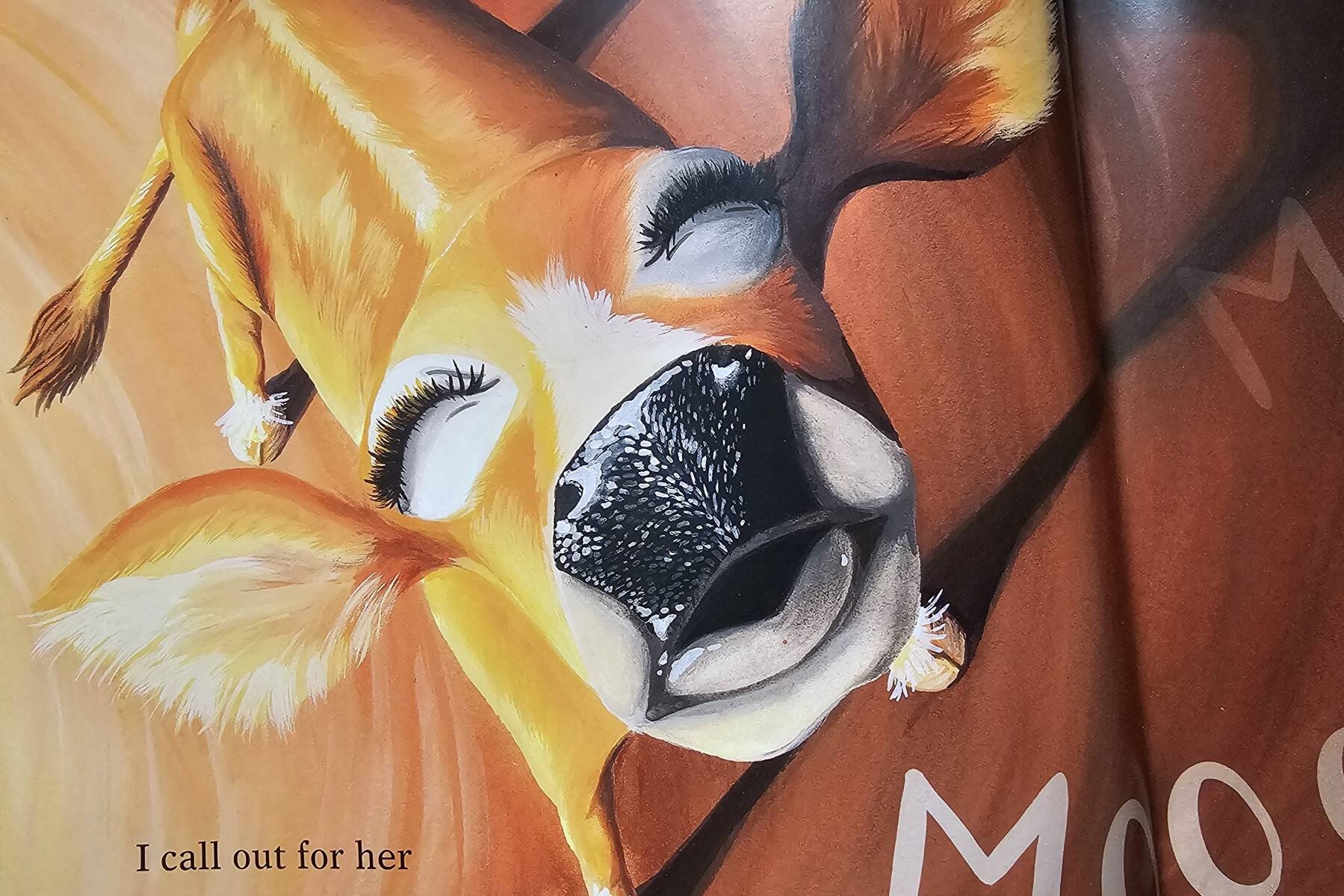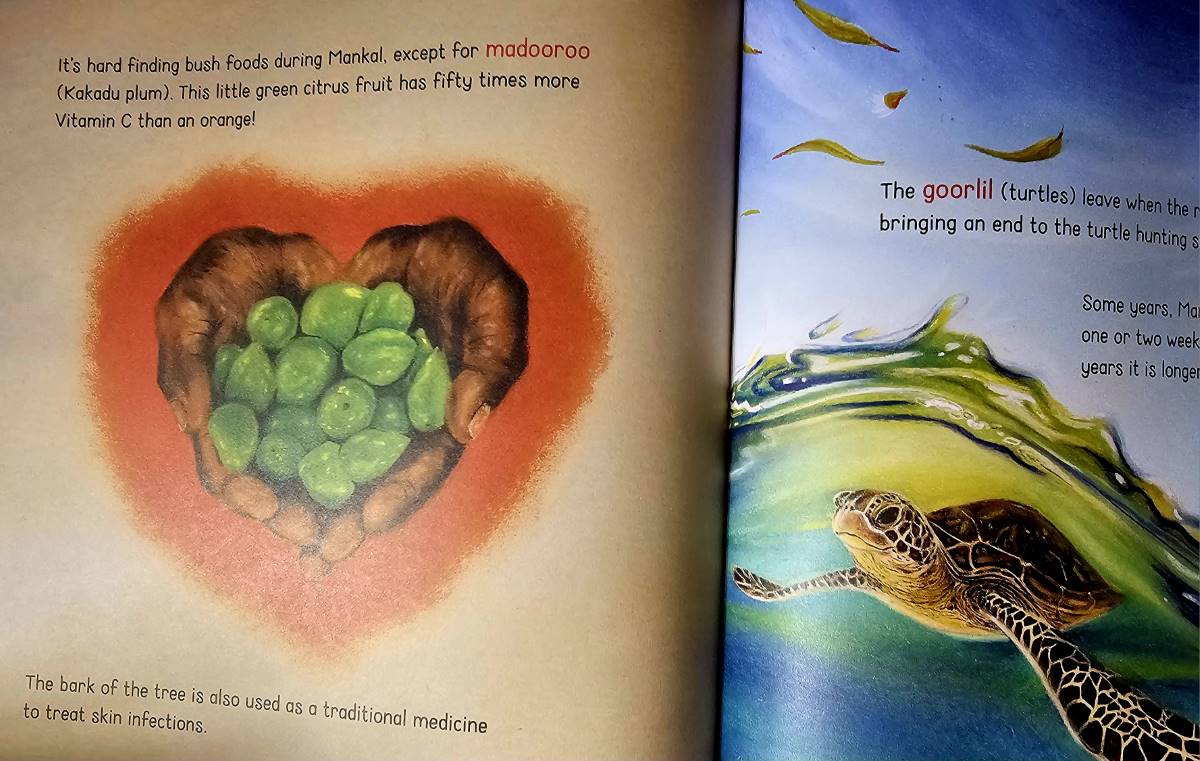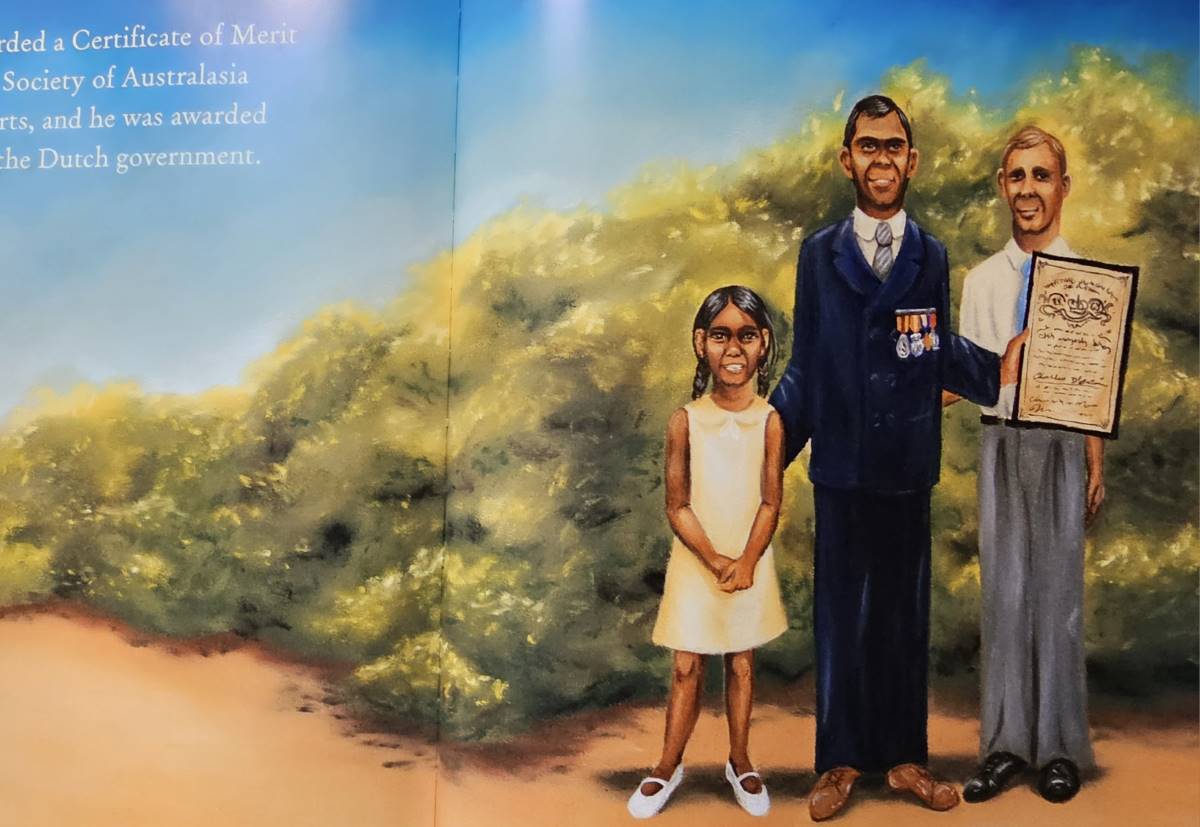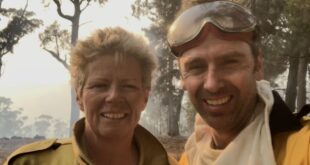
Charmaine in her studio in Blackheath. (Photo: Hamish Dunlop)
Story by Hamish Dunlop
Hamish Dunlop interviews prize-winning children’s book illustrator, mother, activist and proud Bundjalung woman, Charmaine Ledden-Lewis. She talks about the power of storytelling and how we can inspire our children to build a better world. She describes the importance of connecting with Country and explains what it means to be an Indigenous illustrator whose family was part of the Stolen Generations.
When I step onto the verandah, I can see Charmaine though a large glass window. She’s eating breakfast at her kitchen table. When she looks up, there is a flutter of recollection. She opens the door and gracefully ushers me onto the couch. Five minutes later, she’s sitting opposite me wearing faded blue jeans and a white knitted top. The cat is curled up next to her and we’ve both got coffee in our hands.
A children’s book illustrator
In 2019, Charmaine won the prestigious Magabala Books’ Kestin Indigenous Illustrator Award. This was her break into the children’s book industry. It led to her illustrating Bruce Pascoe’s story, Found (2020), and Cathy Freeman’s Born to Run (2021). She has subsequently illustrated Seasons (2023) written by Aunty Munya Andrews and Charlie’s Swim (2022) written by Edith Wright.

A detail from Found written by Bruce Pascoe and illustrated by Charmaine.
Early inspiration
Charmaine was inspired to be a children’s book illustrator by the books she read as a child. My Place, a children’s book published in 1987, was pivotal. It was written and illustrated by Nadia Wheatley and Donna Rawlins. The book captures stories of everyday lives and the richness that percolates out of our relationship with place.

From MY PLACE by Nadia Wheatley and illustrated by Donna Rawlins
Text © 1987 Nadia Wheatley/Illustrations © 1987 Donna Rawlins
Reproduced by permission of Walker Books Australia
Charmaine remembers sitting in a library reading – knowing she was Aboriginal – and being acutely aware of the lack of representations of her life. There was disparity, she recalls, between urban Indigenous living and the predominant representations of Indigenous people being in pre-colonial Australia.
Then one day her mother gave her a copy of My Place. “I though, oh, here’s a kid with the Aboriginal flag in their front window, living somewhere like Tempe or Redfern in Sydney. The book had maps in it,” she recalls, “and mum pointed out where we lived. Looking back, the gift that book gave me was representations of urban Indigenous identity.”
Where the forest meets the sea
Jeannie Baker was another favourite of Charmaine’s. Jeannie’s book, Where the Forest Meets the Sea (1987) explores how humans are part of nature and the magic of that. “She’s been writing since the 1970s and all her books have an environmental message,” Charmaine explains.

From WHERE THE FOREST MEETS THE SEA by Jeannie Baker
Copyright © 1988 Jeannie Baker
Reproduced by permission of Walker Books Australia Pty Ltd
She hands me an autographed copy of Jeannie’s 2023 book, Desert Jungle. It’s signed to Charmaine’s two boys. “It explores the lack of relationship we have with Country,” Charmaine says. She directs me to a quote by Chief Dan George in the title pages: ‘What you do not know you will fear. What you fear, one destroys.’ “I’d add to that,” she says: “What we don’t care about, we don’t protect.”
Seasons of change
Charmaine’s most recent book, Seasons (2023), has been shortlisted for the Wilderness Society’s 2024 Karajia Award. Written by Aunty Munya Andrews, it tells a story about our relationship with Country. “Aunty Munya talks about the way we can pay attention to Country,” Charmaine explains. “How what’s happening on Country informs us about the seasons, rather than the calendar months defining them.”
She recalls her great grandmother taking her for a walk in her own backyard when she was a child. “She’d crush leaves and get me to smell them,” she remembers. “She made that walk around the garden an introduction to Country.”

A detail from Seasons, written by Aunty Munya and illustrated by Charmaine.
Gently rocking the boat
Chamaine tells me that while the message in Seasons is simple and tangible, it’s a starting point to challenge mindsets and perceptions. “It might be ambitious for a storybook,” she considers, “but discovering there are differences between the northern hemisphere concept of seasons and our place, can shift how we frame the world.”
“What happens when we look at it differently?” she asks rhetorically. “If we see differently, we can act differently and who better than children to look at the world with fresh eyes.” Her desire for a better future is palpable. “The way we’re doing things is breaking the world,” she impassions. “Things have got to shift.”
Awe and wonder
As a parent, Charmaine has introduced her children to the awe and wonder of the natural world. “When I was first pregnant and my husband and I were looking to buy somewhere, I couldn’t imagine changing careers and lifestyle to live away from nature. It was really about where to build a nest for baby birds,” she recalls.

A detail from Seasons written by Aunty Munya and illustrated by Charmaine.
A common theme in Charmaine’s book is sunsets. “I go nuts for sunsets!” she exudes. “Sunsets and sunrises with their myriads of colours. A couple of years ago my kids said, “turn off the TV!” “What’s going on?” I asked. “Come check out the sunset,” they called. Her face lights up. “It gave me so much fulfillment,” she says. “To know that I had imbued them with a love for the natural world: it’s often the small things that create big and lasting moments.”
A champion
As well as her current illustration projects, Charmaine speaks at writers’ festivals and does school visits. “Book Week is a big part of a book creator’s year,” she says. “I do up to four sessions a day. I explain about the process of illustration, the team involved, where ideas come from and how they are realised. Exploring the messages within and beyond words is an important part of it.”
As a Varuna board member, Charmaine is passionately championing the children’s programme at the Blue Mountains Writers’ Festival. She is also an ambassador for the Australian Literacy and Numeracy Foundation (ALNF). “ALFN supports marginalised communities,” she tells me. “They work with Indigenous communities to bring about equity and equality: making sure kids have access to books and reading programmes.”
An indigenous illustrator
One of the questions Charmaine is often asked is, ‘Are you an Indigenous illustrator, or an illustrator who does Indigenous-themed illustrations?’ “I find it a strange question,” she muses, “but the thing I’ve realised, is that my time is better spent working on Indigenous-themed books. It’s my form of advocacy, my strength.”

A detail from Born to Run written by Cathy Freeman and illustrated by Charmaine.
As with so many Indigenous families, the enduring effects of the Stolen Generations reverberate in Charmaine’s life. My great grandmother and grandmother were stolen,” she tells me. “My grandmother was three when she was taken into a mission. They were separated and my great grandmother went into domestic slavery. Illustrating books with Indigenous authors has connected me with so many blackfellas,” she says. “I’ve found great power and healing in that.”
Reconciliation
Charmaine tells me it wasn’t just families that were broken in the Stolen Generations. She says the policies of separating people and taking them out of place aimed to fracture culture and language. While the referendum failed to enshrine Indigenous voices in the constitution, she believes the process of reconciliation is continuing to take shape. There is a caveat however: Indigenous ways of engagement must be central.

A detail from Charlie’s Swim. Written by Edith Wright and illustrated by Charmaine.
“As blackfellas, we’re in the process of reclaiming and reinvigorating language and culture: all of those things,” she explains. “We’re designing what these spaces look like for us. It’s not about homogenised Australian Aboriginality. Our ability to bring all Australians into these cultural spaces is something that will take time. Being patient and respectful of this is key to the process of walking together.”
Sunset
The sun is glancing through the windows and we both check the time. “I could talk about these things all day!” Chamaine exclaims. I tell her that she’s in good company and that interviewing her today has been a special treat.
“My mum was a picture book reviewer when I was growing up in New Zealand,” I say. “It’s particularly poignant, because she wrote an academic thesis about the picture book as art. Like you, she believed that children’s books have voices beyond the words.”
Charmaine looks at me thoughtfully and collects the books that we have been discussing and perusing. “Why don’t you take these home,” she says. “No hurry.” She slips them into a tote bag and gently passes them to me. “There are a few signed editions,” she says, patting the top of the pile.”
As I step out the front door into the late autumn afternoon, I feel a huge sense of gratitude. Looking west into the curtailing light, her words reverberate inside me: “What we care about, we protect.”
Share this article:
This story has been produced as part of a Bioregional Collaboration for Planetary Health and is supported by the Disaster Risk Reduction Fund (DRRF). The DRRF is jointly funded by the Australian and New South Wales governments.

More from around the region
Skillshare Saturdays literally offer a `breath of fresh air` at the Planetary Health Centre on the first Saturday of the month! At our free Upcycling Fashion workshop this month you can learn more about all types of zips and how to do basic pockets and pocket flaps. You can bring your own sewing machine or use one of ours. And at Bushcare in the afternoon, you can immerse yourself in the bush at the Planetary Health Precinct as you help restore habitat and protect biodiversity (while meeting some great people and enjoying time in nature). Bookings essential for Upcycling Fashion at Eventbrite here: https://bit.ly/4dZWUoM (link in profile)
If you`d like to join our Bushcare Group contact Karen Hising at khising@bmcc.nsw.gov.au or call the Bushcare Office on 4780 5623
#upcyclingfashion #skillshare #planetaryhealth #bushcare #community #togetherwecan #zerowaste #regeneration #circulareconomy
As 190 countries gather for the @cop16colombia UN Biodiversity Summit, to focus on how we can protect the world’s flora and fauna, we’d like to thank all those local individuals and organisations dedicated to the same goal who came together for World Animal Day at the Blue Mountains Planetary Health Centre on Saturday 5 October. They offered ways for everyone to learn more and take action. From the Blue Mountains Bird Observers, who led over 40 people on a guided Breakfast with the Birds walk, to many others who offered information stalls, talks, workshops, a Wild Life exhibition, live music, plant-based food and hands-on Bushcare. We also launched the Community Plant Based Cooking Project with the first class to be held on Saturday 9 November at @roseyravelstonbooks in Lawson. Places are limited. Learn more here: https://plantinspired.com.au/
#worldanimalday #biodiversity #plantbased #planetaryhealth #bluemountains #katoomba
Did you know that old lino, window putty, and adhesive can contain asbestos? Yesterday the Asbestos & Hazardous Materials Management Conference kicked off with a pre-conference workshop at the Blue Mountains Planetary Health Centre. It included hands-on `spot the asbestos` and asbestos sampling sessions. This year`s theme is `Working together for a safe and healthy future`. #asbestos #hazardousmaterials #conference #planetaryhealth #bluemountains #katoomba
A huge thank you to Josh Logan from Logan Signs, Lithgow, for installing our Circular Water Signage in time for our World Animal Day Celebration today at the Blue Mountains Planetary Health Centre (33-39 Acacia St Katoomba). We have a full program of events with lots of information on how to prepare for the summer ahead and how to create urban areas that help us share our home respectfully with all species. It will be a fun family day too with storytime, craft and live music for kids! (Link in profile) #worldanimalday #planetaryhealth #familyday #katoomba #bluemountains
And our Wild Life exhibition is now up for World Animal Day tomorrow at the Blue Mountains Planetary Health Centre. Photographs by Warren Hinder, Merryl Watkins, Holly Kent and Tracy Burgess. Check out all the other events from stalls, talks, possum box demo, kid`s craft and animal storytime, plant based food and live music to Bushcare. @33-39 Acacia St Katoomba Link in profile. #planetaryhealth #worldanimalday #katoomba
Join the Blue Mountains Planetary Health Initiative at World Animal Day this Saturday 5 October for a discussion on the history of the Plant Based Food Movement in Australia and a discussion of exciting contemporary trends. It will be followed by a Plant Based Cheese Degustation to launch the Plant Inspired Community Cooking Project. This will be a series of cooking classes to introduce the community to plant based cooking techniques. The event is free but places are limited so bookings essential (link in profile): https://bit.ly/3Bzbwhu
#plantbasedcooking #worldanimalday #bluemountains #katoomba #planetaryhealth #communitycooking
We share the Blue Mountains with so many extraordinary beings but have you seen them and do you know their names? Do you know the difference between a Royal Spoonbill and an Eastern Shrike-tit, or the difference between a bandicoot and an antechinus? Come and check out our Wild Life Exhibition at World Animal Day this Saturday to learn more from the stunning photographs by Warren Hinder, Merryl Watkins, Holly Kent and Tracy Burgess. There will be also be a Breakfast with the Birds at 8.30am, Animal Storytime and Craft for kids from 10am, stalls, talks, food and live music. The day is free but please book via Eventbrite to help us cater (link in profile): https://bit.ly/4eMhbz0 @bluemountainswalks @merrylwatkinsphotography @bestofbluemountains
#royalspoonbill #easternshriketit #wildlife #birdsofthebluemountains #bluemountains #katoomba #worldanimalday #biodiversity #planetaryhealth
To coincide with the first day of Bushfire Season we launched Air Watch at the Planetary Health Centre yesterday. For the last seven years Blue Mountains Unions & Community have been working tirelessly to ensure residents of the Blue Mountains and Lithgow are able to measure and track the quality of the air we breathe. The Blue Mountains Planetary Health Initiative has worked closely with them over the last year and now there are 20 PurpleAir monitors distributed throughout the Blue Mountains and Lithgow, including one at the Planetary Health Centre. You can now view real time air quality measurements at each of our local news sites and on the Purple Air Map https://map.purpleair.com We have 10 more sensors available, so if you’d like to install a sensor, members of BMUC will be at World Animal Day at the Planetary Health Centre this Saturday 5 October to take applications and share more information about the project. Bookings for World Animal Day here (link in profile): https://www.eventbrite.com.au/e/world-animal-day-promoting-respectful-cohabitation-tickets-1029328889417
It was a fabulous day yesterday as each speaker highlighted how critically important this project is: Dr Rosemary Dillon CEO of Blue Mountains City Council Trish Doyle MP Dr Jenna Condie from Blue Mountains Parents for Climate Dr Maggie Davidson, environmental scientist from Western Sydney University Matthew Riley, Director Climate and Atmospheric Science from NSW Department of Climate Change, Energy, the Environment and Water and Peter Lammiman and Ann-Maree McEwan from the BMUC’s Airwatch Committee.
@bluemountainsunionists @nswdcceew @bluemountainscitycouncil @westernsydneyu @trishdoylemp @parentsforclimatebluemountains #airqualilty #airqualitymonitors #bluemountains #planetaryhealth
Treat yourself this weekend with a fun-filled and informative World Animal Day event at the Planetary Health Precinct in Katoomba. As well as a Breakfast with the Birds, stalls and a possum box demonstration, there will be a fabulous wildlife exhibition with photos by Warren Hinder, Merryl Watkins, Tracy Burgess and Holly Jayne; live music with Mem Davis, Joe Flood and Duck Keegan; lots of fun for kids with Sharon Baldwin and Naomi Crew leading animal storytime and craft with Julie Refferty; delicious plant based, gluten and dairy free treats, pastries and donuts from Clean Cravings; a plant based cheese degustation and warming Dahl, rice roasted cauliflower with veggies, pakoras, tamarind chutney, and salad courtesy of Bibi’s Kitchen. Come and learn more about Blue Mountains Bird Observers, Blue Mountains Conservation Society, WIRES, Action for Animals Blue Mountains and Animal Sanctuaries, Wombat Rescue, the Women’s Shed, and Animal Welfare Laws in Australia.
Guest speakers throughout the day will include Elizabeth Ellis, lecturer and author of Australian Animal Law; Hal Ginges, a local lawyer and animal activist from Action for Animals who advocates for animal rights and raises money for sanctuaries; Mark Berriman who has been President of the Australian Vegetarian Society NSW since 1989, as well as Co-ordinator for Animal Liberation NSW, Director of the Natural Health Society of Australia and the World League for Protection of Animals; and Teya Brooks Pribac, a researcher in the area of animal studies and the award-winning author of Enter the Animal. She’s also published Not Just Another Vegan Cookbook and will be sharing her culinary skills with the community in the Plant Inspired Community Cooking Project.
The event is free but please book your place to help us cater (link in profile): https://www.eventbrite.com.au/e/world-animal-day-promoting-respectful-cohabitation-tickets-1029328889417
#worldanimalday #plantbased #planetaryhealth #katoomba #bluemountains
We are so looking forward to kicking off World Animal Day Celebrations on Saturday 5 October with an 8.30am Breakfast with the Birds. Join Paul Nagle from the Blue Mountains Bird Observers on a guided bird walk around the Planetary Health Precinct visiting different habitats on the site to observe and talk about the birdlife that is resident and that visits the site. Binoculars are highly recommended.
World Animal Day will be an inspiring family day celebrating the extraordinary diversity of animals we share our world with! The theme is `Promoting Respectful Cohabitation`. Bookings for the Breakfast with the Birds (link in profile)
or here:
https://www.eventbrite.com.au/e/breakfast-with-the-birds-tickets-1028664983657
#birdlife #breakfastwiththebirds #katoomba #worldanimalday #bluemountains #planetaryhealth #respectfulcohabitation





